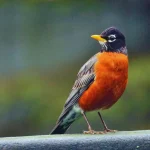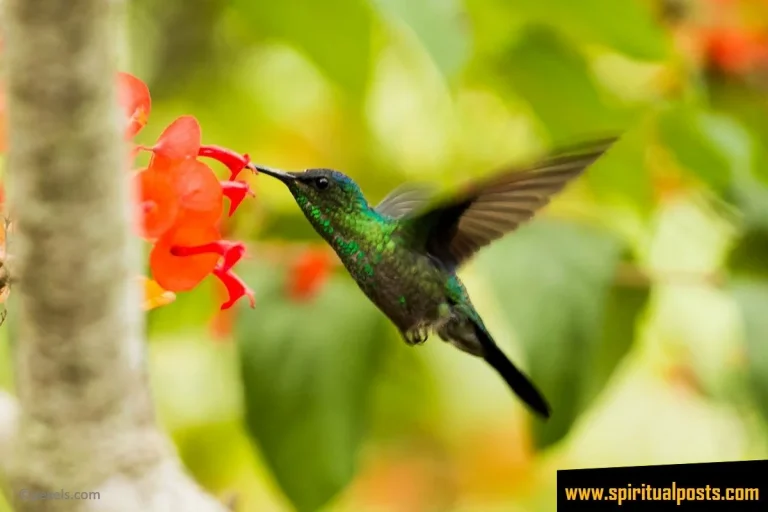Warbler Spiritual Meanings and Symbolism

You might not expect it, but the small, colorful warbler holds deep meaning in many cultures. Its bright feathers and sweet songs do more than please the eye and ear—they symbolize happiness, new beginnings, and the wonder of nature.
Since warblers migrate, they also represent the cycle of life, teaching us to accept change and adjust when needed. Most importantly, these little birds encourage spiritual refreshment and a stronger bond with something greater than ourselves.

Key Takeaways
- Warblers represent joy, renewal, and the beauty of nature, symbolizing opportunities for spiritual rejuvenation and a deepened connection to the natural world.
- Warblers’ remarkable adaptability and resilience serve as a metaphor for the human journey of growth and self-discovery, inspiring us to embrace life’s changes and challenges.
- Warblers’ captivating melodies are seen as a conduit for divine expression and a celebration of life, providing inspiration and a reminder to embrace the present moment.
- In various cultural and spiritual traditions, warblers are revered as messengers between the physical and metaphysical realms, representing the soul’s journey towards enlightenment.
Introduction to the Warbler
Warblers are tiny, lively songbirds that bird lovers adore for their vibrant colors and beautiful tunes. They belong to the Parulidae family, which includes over 50 species across North America. You can recognize them by their small size, sharp beaks, and unique markings, with colors ranging from sunny yellow to striking patterns like the Blackburnian Warbler.
What really sets warblers apart is their amazing singing talent. They fill spring and summer air with a mix of trills, whistles, and complex melodies. Whether hopping through leaves or singing from a treetop, their energy and sounds make them a favorite among nature lovers. Learning about their spiritual meaning opens up a world where birds and human experiences connect in surprising ways.
What Does It Mean When You See a Warbler?
Spotting a warbler isn’t just lucky—it might carry a special message for you. These birds often stand for joy, fresh starts, and nature’s beauty, nudging you to enjoy life’s simple moments. Their cheerful songs and quick movements remind you to live in the present and appreciate small wonders.
A warbler’s appearance could also mean it’s time to trust your gut. Just as these birds sense shifts in their surroundings, they might be telling you to listen to your inner voice. Their migratory habits also symbolize change, encouraging you to adapt and grow through life’s ups and downs.
Warbler Symbolism
Warblers carry powerful meanings that can inspire personal growth. They represent happiness and renewal, reminding you to stay curious and lighthearted. Watching them dart between branches shows how flexibility helps overcome obstacles with ease.
Since warblers travel with the seasons, they also reflect life’s natural cycles. Their presence may urge you to let go of the past and welcome new phases. By tuning into their wisdom, you might find peace and a stronger tie to nature.
7 Spiritual Meanings of Warbler
1. Warbler’s Joyous Melodies
The warbler’s cheerful songs are more than just pleasant sounds—they carry a deeper meaning. These tiny birds sing with so much energy that their music feels alive. When they chirp and trill from the trees, it lifts your mood and fills the surroundings with something special.
Their songs aren’t random noises. People across different cultures believe that the warbler’s melodies are spiritual messages. They think the bird is expressing emotions that come straight from the soul. Some even say its music helps us connect with something greater than ourselves.
When you hear a warbler sing, it can feel like nature is celebrating. The sounds remind us of how beautiful and full of life the world is. They speak to the heart in a quiet but powerful way.
In many places, people see the warbler as a symbol of hope and renewal. Its song becomes a gentle reminder that joy can be found in small things. Listening closely might even help you feel more grounded and present in the moment.
2. Warbler’s Connection to Nature
Warblers don’t just live in nature—they seem to be in tune with it. They move through leaves and branches so easily, as if they’re a part of the trees themselves. Watching them can remind you of how all living things are linked together.
Even though they’re small, warblers play a big role in their surroundings. Every hop and flutter feels like part of a dance that keeps nature balanced. It’s like they understand their place in the big picture of life.
These birds follow the seasons without needing a calendar. They know when to migrate, when to sing, and where to go. Their actions show a deep connection to the Earth’s cycles and rhythms.
By noticing how the warbler lives, you start to think about your own place in the world. Their presence encourages you to appreciate nature more and recognize how connected everything truly is.
3. Warbler’s Adaptability and Resilience
One of the most amazing things about warblers is how adaptable they are. Whether they’re in thick forests or busy cities, they find ways to survive. Their small bodies help them move quickly and safely through all kinds of places.
Even when their homes are disturbed, warblers don’t give up. They look for new places to live and new food to eat. They adjust without complaining, finding ways to keep going. This kind of strength can inspire you in your own life.
Life throws challenges at everyone. The warbler’s ability to adjust shows that it’s possible to keep moving forward, even when things don’t go as planned. Their story is one of survival, courage, and smart choices.
By watching warblers, you can learn a lot about how to handle change. They prove that being flexible and alert can help you through tough times.
4. Warbler’s Symbolism of Change
The warbler is often seen as a symbol of change and movement. They rarely stay in one place for long, constantly adjusting to what’s around them. This reminds you that change is a normal and natural part of life.
As these birds move from tree to tree, it becomes clear that change doesn’t have to be scary. It can be smooth and even graceful. Warblers seem to accept what comes without hesitation or fear.
They survive and thrive in all kinds of situations. That kind of adaptability is a reminder to stay open to new things. With a flexible mindset, you can handle life’s ups and downs with more ease.
The warbler encourages you to stay curious. When you’re open to new experiences, you grow stronger. Like the warbler, you can face change not as a threat—but as an opportunity.
5. Warbler’s Representation of Hope
The warbler’s song is filled with light and joy, even in difficult times. Its cheerful voice reminds you that there’s always something good to hold on to. In a world full of change, the warbler becomes a symbol of steady hope.
It’s not just the sound that matters—it’s how the warbler keeps singing no matter where it is. Whether in quiet woods or busy neighborhoods, this little bird finds reasons to sing. That’s a powerful message about staying hopeful.
Warblers are strong in quiet ways. They go through long migrations, face weather changes, and still manage to bring their sweet songs to life. That kind of resilience carries a hopeful message for everyone.
When you hear a warbler sing, it’s a gentle reminder that new beginnings are always possible. Even if life is hard right now, there’s always a path forward.
6. Warbler’s Lessons of Patience
Warblers don’t rush through life. If you watch them closely, you’ll see how calmly they move from branch to branch. Their quiet movements can teach you something important: patience matters.
They take their time, always watching and waiting for the right moment. Whether they’re catching food or building a nest, they move with care. This shows the value of being thoughtful and not hurrying.
Their songs aren’t loud or fast either. They have a peaceful rhythm, reminding you to slow down and enjoy what’s around you. There’s beauty in taking things step by step.
In a world that’s always rushing, the warbler gives you permission to pause. Sometimes, the best things in life happen when you’re not in a hurry.
7. Warbler’s Spiritual Awakening
Seeing a warbler in motion can feel like watching something sacred. Its movements are light and free, as if it’s guided by something higher. This makes the warbler a symbol of spiritual awakening.
The bird doesn’t stay stuck. It’s always moving, always learning, always adjusting. This shows that spiritual growth isn’t about staying the same—it’s about being open to new paths and new ways of thinking.
Warblers don’t only live in quiet forests. You might hear one in your own backyard. Their presence reminds you that spiritual experiences can happen anywhere—not just in temples or special places.
By watching the warbler, you may start to notice more signs in the world around you. It can help you feel more connected, more aware, and more open to whatever your own journey brings.
Warbler Symbolism in Different Cultures and Contexts
The warbler is more than a small, colorful bird with a sweet song. Across the world, people have given it deep spiritual and cultural meaning. Its bright feathers and cheerful voice have left strong impressions in many traditions. From Native American beliefs to Eastern philosophies, this little bird carries messages that go far beyond its size.
Each culture has its own view of the warbler, shaped by local customs and spiritual ideas. Some see it as a messenger, while others believe it stands for renewal or transformation. The warbler often shows up in myths, stories, and art, reminding people of nature’s wisdom and beauty. Its role in different places reflects how connected humans feel to the natural world.
Let’s take a closer look at how the warbler appears in different cultures. These beliefs give us insight into how people relate to the world around them. By learning how others see the warbler, we can better understand the values and hopes they hold dear.
Native American Culture
In Native American traditions, the warbler is seen as a special bird with deep meaning. Its colorful feathers and lively song are thought to connect people to the natural world. Many tribes believe the warbler is a messenger from nature, bringing signs and spiritual guidance.
This bird’s movement between the earth and the sky is seen as a symbol of how everything is connected. Its quick flying and alert nature show the power of being aware and ready to adapt. To many, these traits are reminders to stay sharp and live in harmony with the world.
The warbler’s song carries a message too. It’s not just a sound—it’s a call to listen more closely to life. Some believe it helps people hear the quiet wisdom around them. It’s a sound that reminds them to slow down and find peace.
In certain ceremonies, warbler feathers are used for their spiritual meaning. People may wear them or include them in sacred rituals. By doing this, they hope to gain the bird’s qualities, such as awareness, flexibility, and spiritual insight.
Celtic Culture
In Celtic beliefs, the warbler also holds a powerful place. Its bright appearance and lovely voice are linked to the idea of change and new beginnings. The Celts respected birds for their closeness to the heavens, and the warbler was no exception.
The way it moves through trees and sings was seen as a sign of the soul’s journey. Celts believed its song welcomed the arrival of spring and the start of a fresh cycle. It became a symbol of hope, showing that brighter days were coming.
Celtic druids and spiritual leaders often connected birds to the unseen world. The warbler, in particular, was linked to the element of air and the spirit realm. They believed it helped people reach higher understanding during rituals or moments of reflection.
This bird was more than just a symbol—it was seen as a guide. By watching or hearing it, people felt closer to nature and their inner selves. In Celtic stories and ceremonies, the warbler remained a sign of deep spiritual meaning.
Nordic Culture
In Norse traditions, the warbler stood out for its delicate and otherworldly nature. People in ancient Nordic lands often saw it as a link between humans and the gods. Its sweet song seemed to travel between worlds, touching both earth and the divine.
The warbler was often tied to Freyja, the goddess of love, beauty, and life cycles. Some believed her golden tears turned into flowers where the warbler liked to rest. This made the bird a symbol of life, death, and renewal.
Its ability to move quickly and lightly among trees showed the soul’s path in Norse thinking. It was not just a bird—it was a reminder that life is always moving and changing. People listened to its song as if it carried messages from beyond.
Nordic respect for nature was strong, and the warbler became part of that love. Through this bird, people felt connected to their myths, their gods, and the deeper truths of life.
African Culture
Across Africa, the warbler is also known for its joyful and spiritual meaning. Its beautiful song is often linked to happiness, blessings, and the flow of life. When people hear its call, they may believe that positive change or prosperity is on the way.
In many African beliefs, birds act as go-betweens for the spiritual and physical worlds. The warbler, with its fast flight and gentle tune, is seen as a messenger. People pay attention to its behavior, thinking it could be sending a warning, blessing, or guide.
The warbler’s bright feathers and lively actions stand for growth and change. When seasons shift, these birds return, reminding people that life also moves in cycles. Their arrival is often met with celebration or reflection.
Because of its strength and ability to adjust to its surroundings, the warbler also represents resilience and inner power. Across different African traditions, this little bird continues to inspire and teach valuable lessons.
Eastern Culture
In Eastern countries, the warbler’s song and graceful presence have also earned it a meaningful place. In Japan, it signals the start of spring, bringing hope and fresh energy. People often write poems or paint pictures to capture its peaceful image.
In Chinese beliefs, the warbler is seen as a bringer of good luck and renewal. Its visit is thought to mark happy times ahead. Artists and writers have long included it in their work to celebrate beauty and life’s gifts.
In India, the warbler connects to deep spiritual ideas. Its light movement from tree to tree reminds people of the soul’s rise toward higher truths. The bird’s presence is linked to moksha, or spiritual freedom beyond the cycle of rebirth.
These different meanings all highlight the bird’s importance in the East. Whether through art, religion, or poetry, the warbler reminds people to look deeper and stay open to new beginnings.
Hindu Culture
Within Hindu traditions, the warbler is a symbol of deep spiritual movement. It’s not just a bird; it shows how the soul can travel between worlds. Many see its flight as a picture of the journey toward spiritual freedom.
The bird’s song is more than sound—it’s a kind of vibration that matches the rhythm of the universe. People believe it can help bring peace and clarity, guiding them to feel more connected to the world around them.
In art and stories, the warbler often appears near wise figures, especially Saraswati, the goddess of learning and music. Her connection to the warbler makes the bird a sign of divine knowledge and creativity.
Hindus believe that by tuning in to nature’s smaller signs—like a warbler’s song—they can find deeper truths. These birds act as quiet teachers, leading people along the spiritual path.
Arts and Literature
The warbler shows up often in books, poems, and paintings. Artists across the world have seen it as a symbol of joy, hope, and nature’s beauty. Its presence often adds a light, peaceful feeling to creative work.
In poems by writers like Wordsworth and Dickinson, the warbler’s song is tied to human emotions. Its voice lifts the heart, reminding readers of life’s bright side. The bird becomes a small, joyful piece of the world’s larger picture.
In paintings, especially from the Impressionist period, warblers appear in gardens and forests. Artists tried to show the bird’s quick, fleeting energy through soft colors and gentle strokes.
The warbler also pops up in stories told to kids. In these tales, it often plays the role of a cheerful helper or sign that spring has arrived. These stories help pass down the bird’s meaning to younger generations.
Mythology
Warblers are found in many myths, often as signs from the spirit world. In Native American stories, they’re thought to carry messages from ancestors. Their arrival signals a new season or a time for personal change.
The Greeks connected the warbler to Erato, the muse of poetry. Its song was believed to stir deep feelings and spark creativity. Poets saw the bird as a gift from the heavens.
In Chinese stories, its song was said to heal sadness and bring peace. People would sit quietly and listen, hoping to feel more balanced and calm.
These old tales show how powerful a small bird can be. The warbler’s role in myths proves that people across time have looked to nature for answers and inspiration.
Warbler Biblical Meanings
In the Bible, the warbler is not mentioned by name, but its traits match many spiritual ideas in scripture. Its bright colors and peaceful song are often tied to God’s creation. People see the warbler as a symbol of divine beauty and life’s richness.
Verses in Jeremiah and Psalms speak about powerful voices and sounds from nature. These have been compared to the warbler’s song—strong yet gentle, and full of meaning. Its music seems to echo deeper truths.
The bird’s seasonal travels also connect to verses like Ecclesiastes 3:1, which talks about times and seasons. The warbler’s coming and going reminds people that change is natural and can bring growth.
Its colorful feathers reflect the beauty and detail found in creation. In this way, the warbler becomes a picture of God’s love and the soul’s longing for something higher.
Spiritual Meaning of Dream About Warbler
Dreaming about a warbler can be a message from your inner self. The bird might be telling you to pay closer attention to what’s happening around you. Its gentle presence can stand for renewal, awareness, or a spiritual nudge.
If you hear the warbler singing in your dream, it could mean it’s time to speak your truth. Maybe you’ve been quiet for too long, and your spirit wants to be heard. The bird’s song is a sign to share your voice with confidence.
Watching a warbler fly through your dream might mean you’re ready to move forward or accept change. Its light, flexible flight can show you how to let go and trust where life takes you.
Look at the details of the dream. How the warbler acts or where it appears can give more clues. These moments often hold guidance for what’s going on in your spiritual or emotional life.
Warbler Spirit Animal, Totem, and Power Animal
If the warbler is your spirit animal, it may be asking you to slow down and listen more closely to nature and your own thoughts. Its quiet song reminds you that even the smallest voices can carry deep truth.
As a totem, the warbler brings a strong connection to intuition and personal expression. It encourages you to speak clearly and act with purpose. You don’t have to be loud to make an impact.
When it appears as a power animal, the warbler asks you to stay curious and open to the world around you. Its ability to adapt and stay light on its feet teaches you to move through life with grace and awareness.
The warbler is a symbol of strength in a small form. By connecting with its energy, you may find new ways to face challenges and grow spiritually.
You Might Also Like
1) Black Bird Spiritual Meanings and Symbolism
2) Black and Orange Bird Spiritual Meanings & Symbolism
3) 7 Spiritual Meanings of Bluebird & Symbolism: Joy, Hope
4) Blue Cardinal Spiritual Meanings and Symbolism
5) Black Duck Spiritual Meanings and Symbolism

















